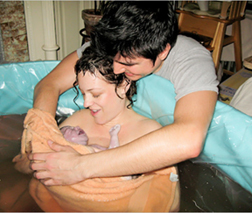Reading on another blog recently, I came across an interesting comment by a physician. He wrote that he disagrees with a statement he frequently hears, that "midwifery care is superior care”. Well, I’m here as a midwife to tell you that midwifery care is not superior care.
- Midwives are not as highly educated as physicians. Regardless of what type of midwife you might see, she will not have an education equivalent to that of an OB, who has gone to four years of college, four years of medical school, and at least an additional four years of residency.
- Midwives cannot perform certain procedures that an OB can perform. Some examples would be cesarean section, gynecological surgery, and forceps deliveries.
- OBs, by virtue of their more comprehensive education, have greater in-depth knowledge of complications of pregnancy and birth.
After hearing this, you might be thinking, “An OB is definitely the best choice then, for prenatal care.” But let me share with you what I see as the best features of midwifery care:
- Midwives listen more. While there are many OBs who are good listeners, they generally have a much tighter schedule than midwives, on average allowing only 5-10 minutes per prenatal visit. Contrast this with the 30-60 minutes a midwife allows. The greater time at a midwife visit permits both parties to develop a real relationship. Listening also allows midwives to pinpoint when things aren’t going right, as in this experience related by a midwife friend of mine:
“I was approached by a woman in my community who was receiving prenatal care from a local OB. She asked for a consultation, and told me she was greatly concerned about symptoms of intense itching that she kept experiencing. The itching was so severe that she was scratching in her sleep until her skin bled. She’d gone to her OB several times, and each time he told her not to worry, that she had something called PUPPs, and it would go away when the baby was born. He finally told her to stop calling him about the itching, because nothing could be done for it. I didn’t have any knowledge about her problem that the OB didn’t have, and in fact, I had no idea what could be wrong. But I listened carefully to her concerns, and she was worried that something more serious was wrong. She told me she’d had hepatitis A as a child, and wondered if this could be related? I had no idea! But I told her I would do some research. I studied in my Williams Obstetrics, and read about a condition called obstetric hepatosis, which could cause intense itching, elevated liver enzymes, and in extreme cases, stillbirth. I ordered some blood tests for her, and sure enough, her liver enzymes were elevated. I copied the pages from the textbook and the lab reports and gave them to the woman, who by now had decided she wanted a home birth with me. When she took the information to her doctor, he looked at it, diagnosed her with obstetric hepatosis and told her that her condition was too high risk to be managed by only a midwife. I did not have any special knowledge that I used, but I did use my ability to listen to this woman and trust her intuition that something was wrong, and then I searched until I found the answer.”
- Midwives talk more. How could talking more be a good thing? Let me share an experience that is representative of a situation I encounter at least once a month. A woman came for her first prenatal visit, accompanied by a friend. At the first visit, I normally go over all the tests she will be offered during the pregnancy, give her information on the risks and benefits, and let her know that she has the right to either accept the test or decline it, and her choice will not affect our care of her. The woman’s friend kept asking me questions about the glucose test, the quad screen, and the group B strep test. As they were leaving, she told me, “I had all those tests done during my pregnancy, but I never knew why. My doctor only told me they were required and nothing more. I learned more here in one hour than I learned my entire pregnancy with my OB!” While I don’t have more knowledge than an OB, all the knowledge in the world does little good if it is not shared with the woman who will be the recipient of it. It is a simple thing to explain risks and benefits of procedures, and ask the woman what her thoughts and questions are. Another woman came to my office asking me to accept her as a transfer patient, three days before her due date! I don’t mind taking transfer patients at any time, but I sensed she was not really seeking midwifery care, but just frustrated with her doctor. I asked some questions, and she revealed that she was tired of being pregnant and wanted her doctor to induce her. She was upset that he would not discuss it with her, but just said “NO”. I spent half and hour with her, explaining the risks of induction, the benefit of letting labor start on its own, and reassuring her that she had the strength to wait out these last few days of pregnancy. She was so appreciative as she left, hugging me, and thanking me for taking the time to explain to her the things her doctor never did.
- Midwives more often do nothing. This doesn’t sound like an attribute until you realize that many wise midwives and physicians have said the hardest thing to learn is the art of sitting on your hands. The temptation to intervene and “help” the laboring woman with her work is sometimes overwhelming. Midwives often do nothing more than simply be present. That presence can be life-saving, as I have had multiple experiences where I was working in a hospital setting, and something I noticed because of being with the woman continually during labor tipped me off to the fact that there was a problem. I’ve delivered many babies by myself in the hospital because the nurses were out of the room and the baby came before they could respond to the call light. Although many physicians bristle at the notion that midwives are experts in normal birth, just ask one if they have ever sat through an entire labor with a woman, from start to finish. So far, I have yet to meet an OB who has ever done this. An ‘aha’ moment occurred for me when I watched Ricki Lake’s DVD, The Business of Being Born. Three resident OB physicians from Columbia University were being interviewed, and were asked how often they saw a normal birth occur. The three looked at each other blankly, and finally one resident admitted, “Never”. An experienced midwife has observed normal labor in its entirety so frequently, that if labor becomes complicated, she will pick up quickly on subtle indications that all is not well. As I often tell my students, it’s impossible to learn every possible complication and condition. It’s much more important to know what is normal–backwards and forwards–so that when you see something that’s NOT normal, you will know right away and can get appropriate consultation in a timely manner.
It all boils down to the fact that midwives do NOT give superior care. They give different care. As long as we persist in drawing a line in the sand, and each camp thinking they are better than the other, we can’t give optimal care to the people who really matter the most–the women we serve. A recent editorial in the Journal of Family Practice stressed the need to work together, rather than compete. I can’t compete with what an OB does best, but I don’t think most OBs can compete with what I do best. We each excel in our own area.
Over two hundred years ago, Dr. Benjamin Rush, a physician (Rush Medical School is named after him) and signer of the Declaration of Independence, had this to say about competition among health care providers:
“The Constitution of this Republic should make special provision for medical freedom. To restrict the art of healing to one class will constitute the Bastille of medical science. All such laws are un-American and despotic. … Unless we put medical freedom into the constitution the time will come when medicine will organize into an undercover dictatorship and force people who wish doctors and treatment of their own choice to submit to only what the dictating outfit offers.”¹
It is high time we recognize the unique abilities we each bring to the table, and work together to build respect among all of us, so we can offer the best of care to women and their babies.
1. The Wellness Directory of Minnesota. The history of medicine. Retrieved 12/13/10 from: http://www.mnwelldir.org/docs/history/history03.htm
http://www.themidwifenextdoor.com/?p=1320

 For many of us who haven't yet been through childbirth, there's an image we have of what it's like: A woman is rushed to the hospital in a taxi; she gets put in a wheelchair and is rolled down the hallway in dire emergency; then we see her screaming, and yelling in pain and then... there's the baby.
For many of us who haven't yet been through childbirth, there's an image we have of what it's like: A woman is rushed to the hospital in a taxi; she gets put in a wheelchair and is rolled down the hallway in dire emergency; then we see her screaming, and yelling in pain and then... there's the baby. You can go to any other developed country in the world, and you will find that they are losing fewer women and fewer babies around the time of birth. The important thing to know here is that in these countries,
You can go to any other developed country in the world, and you will find that they are losing fewer women and fewer babies around the time of birth. The important thing to know here is that in these countries, 


 Birth should be an awesome thing with as much focus on making it as easy and safe for you as possible, and of course, as safe as possible for the baby as well.
Birth should be an awesome thing with as much focus on making it as easy and safe for you as possible, and of course, as safe as possible for the baby as well.
